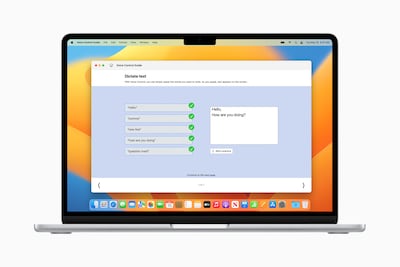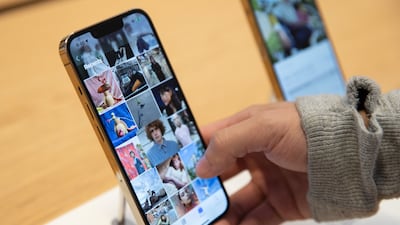Apple has previewed a wide range of new accessibility features ahead of its Worldwide Developers Conference next month.
The updates, which will be available later this year, include those for cognitive, vision, hearing and mobility accessibility, as well as the latest tools to help those who are non-speaking, or are at risk of losing their ability to speak, the company said on Wednesday.
They will be available on Apple's iPhones, iPads and Macs. Apple is expected to showcase the new features at the WWDC, which runs from June 5 to 9 at its headquarters in Cupertino, California.
“Apple works in deep collaboration with community groups representing a broad spectrum of users with disabilities to develop accessibility features that make a real impact on people’s lives,” the company said.
More than one billion people live with some form of disability, corresponding to about 15 per cent of the global population. They are considered to be the world's biggest minority, according to the World Health Organisation.
Technology can help them dramatically in communicating and carrying out their daily lives, it said. Companies like Apple have been conducting research and integrating next-generation accessible technology into their devices.
“The best technology is technology built for everyone,” Apple chief executive Tim Cook said.
The company's accessibility services “build on our long history of making technology accessible, so that everyone has the opportunity to create, communicate and do what they love”, he said.
Assistive Access for users with cognitive disabilities
Assistive Access will give a customised experience while on a call or on the FaceTime app, which have been combined into a single app named Calls. It will also be featured on messages, camera, photos and music.
The feature offers a distinct interface with high-contrast buttons and large text labels, plus tools to help “trusted supporters tailor the experience for the individual they support”.
For example, on Messages, if a user favours communicating visually, they can use an emoji-only keyboard or record a video message.
Let them hear what you type with Live Speech
Live Speech will allow users to type a message then have it spoken on phone and FaceTime calls. Commonly used phrases can be saved so they can easily be accessed and sent during conversations.
Personal Voice, meanwhile, is aimed at users at risk of losing their ability to speak or other conditions that can progressively impact speaking ability. Users can create a “personal voice” by reading a randomised set of text to record 15 minutes of audio on an iPhone or iPad.
Apple said these tools use machine learning to keep user information private and secure, and that they were designed “to support millions of people globally who are unable to speak or who have lost their speech over time”.
Detection Mode for users with vision challenges
For those with vision disabilities, Apple has introduced point-and-speak on its magnifier feature, which lets users interact with physical objects that have several text labels.
Citing an example of a microwave oven, Apple said point-and-speak combines input from the camera, the light detection scanner known as Lidar and machine learning to announce the text on each button as users move their finger across the keypad.
Point-and-speak can also be used with other accessibility features, including voice over, people detection, door detection and image descriptions to help users navigate their physical environment.
Other new features announced include the ability to pair made-for-iPhone hearing devices directly to Mac, and an easier way to adjust text size across certain apps and phonetic suggestions on voice control that lets users choose the right word out of several that may sound alike.
Also, users with physical and motor disabilities who use switch control can turn any switch into a virtual game controller to play games on an iPhone or iPad, while those who are sensitive to rapid animations can automatically pause images with moving elements, such as GIFs, in Messages and Safari.
Apple also revealed several new accessibility features on its devices last year aimed at assisting users who are physically challenged.
Notable Yas events in 2017/18
October 13-14 KartZone (complimentary trials)
December 14-16 The Gulf 12 Hours Endurance race
March 5 Yas Marina Circuit Karting Enduro event
March 8-9 UAE Rotax Max Challenge
Key findings of Jenkins report
- Founder of the Muslim Brotherhood, Hassan al Banna, "accepted the political utility of violence"
- Views of key Muslim Brotherhood ideologue, Sayyid Qutb, have “consistently been understood” as permitting “the use of extreme violence in the pursuit of the perfect Islamic society” and “never been institutionally disowned” by the movement.
- Muslim Brotherhood at all levels has repeatedly defended Hamas attacks against Israel, including the use of suicide bombers and the killing of civilians.
- Laying out the report in the House of Commons, David Cameron told MPs: "The main findings of the review support the conclusion that membership of, association with, or influence by the Muslim Brotherhood should be considered as a possible indicator of extremism."
UAE v Zimbabwe A
Results
Match 1 – UAE won by 4 wickets
Match 2 – UAE won by 5 wickets
Match 3 – UAE won by 25 runs
Match 4 – UAE won by 77 runs
Fixture
Match 5, Saturday, 9.30am start, ICC Academy, Dubai
Section 375
Cast: Akshaye Khanna, Richa Chadha, Meera Chopra & Rahul Bhat
Director: Ajay Bahl
Producers: Kumar Mangat Pathak, Abhishek Pathak & SCIPL
Rating: 3.5/5
Cricket World Cup League 2 Fixtures
Saturday March 5, UAE v Oman, ICC Academy (all matches start at 9.30am)
Sunday March 6, Oman v Namibia, ICC Academy
Tuesday March 8, UAE v Namibia, ICC Academy
Wednesday March 9, UAE v Oman, ICC Academy
Friday March 11, Oman v Namibia, Sharjah Cricket Stadium
Saturday March 12, UAE v Namibia, Sharjah Cricket Stadium
UAE squad
Ahmed Raza (captain), Chirag Suri, Muhammad Waseem, CP Rizwan, Vriitya Aravind, Asif Khan, Basil Hameed, Rohan Mustafa, Kashif Daud, Zahoor Khan, Junaid Siddique, Karthik Meiyappan, Akif Raja, Rahul Bhatia
FULL%20RESULTS
%3Cp%3E%3Cstrong%3EMiddleweight%20%3C%2Fstrong%3E%3C%2Fp%3E%0A%3Cp%3EEslam%20Syaha%20(EGY)%20bt%20Robin%20Roos%20(SWE)%20%0D%3Cbr%3E%3Cstrong%3E%0D%3Cbr%3EWelterweight%20%3C%2Fstrong%3E%3C%2Fp%3E%0A%3Cp%3EAlex%20da%20Silva%20(BRA)%20bt%20Bagyash%20Zharmamatov%20(KGZ)%20%0D%3Cbr%3EMurodov%20Samandar%20(TJK)%20bt%20Lucas%20Sampaio%20(BRA)%20%0D%3Cbr%3EShakhban%20Alkhasov%20(RUS)%20bt%20Salamat%20Orozakunov%20(KGZ)%0D%3Cbr%3EKhotamjon%20Boynazarov%20(UZB)%20bt%20Mikail%20Bayram%20(FRA)%20%0D%3Cbr%3E%0D%3Cbr%3E%3Cstrong%3EBantamweight%20%3C%2Fstrong%3E%0D%3Cbr%3EJieleyisi%20Baergeng%20(CHN)%20bt%20Xavier%20Alaoui%20(CAN)%20%0D%3Cbr%3E%0D%3Cbr%3E%3Cstrong%3EFlyweight%20%3C%2Fstrong%3E%0D%3Cbr%3ERashid%20Vagabov%20(RUS)%20bt%20Lun%20Qui%20(CHN)%20%0D%3Cbr%3EYamato%20Fujita%20(JPN)%20bt%20Furkatbek%20Yokubov%20(UZB)%20%0D%3Cbr%3EAaron%20Aby%20(WLS)%20bt%20Joevincent%20So%20(PHI)%20%0D%3Cbr%3E%0D%3Cbr%3E%3Cstrong%3ECatchweight%20176lb%20%3C%2Fstrong%3E%0D%3Cbr%3EMark%20Hulm%20(RSA)%20bt%20Erkin%20Darmenov%20(KAZ)%20%0D%3Cbr%3E%0D%3Cbr%3E%3Cstrong%3ECatchweight%20160lb%20%3C%2Fstrong%3E%0D%3Cbr%3ERustam%20Serbiev%20(BEL)%20bt%20Anar%20Huseyinov%20(AZE)%20%0D%3Cbr%3E%0D%3Cbr%3E%3Cstrong%3ECatchweight%20150lb%20%3C%2Fstrong%3E%3C%2Fp%3E%0A%3Cp%3EIslam%20Reda%20(EGY)%20bt%20Ernie%20Braca%20(PHI)%0D%3Cbr%3E%0D%3Cbr%3E%3Cstrong%3EFlyweight%20(women)%3C%2Fstrong%3E%20%0D%3Cbr%3EBaktygul%20Kurmanbekova%20(KGZ)%20bt%20Maria%20Eugenia%20Zbrun%20(ARG)%20%0D%3Cbr%3E%3C%2Fp%3E%0A
Trump v Khan
2016: Feud begins after Khan criticised Trump’s proposed Muslim travel ban to US
2017: Trump criticises Khan’s ‘no reason to be alarmed’ response to London Bridge terror attacks
2019: Trump calls Khan a “stone cold loser” before first state visit
2019: Trump tweets about “Khan’s Londonistan”, calling him “a national disgrace”
2022: Khan’s office attributes rise in Islamophobic abuse against the major to hostility stoked during Trump’s presidency
July 2025 During a golfing trip to Scotland, Trump calls Khan “a nasty person”
Sept 2025 Trump blames Khan for London’s “stabbings and the dirt and the filth”.
Dec 2025 Trump suggests migrants got Khan elected, calls him a “horrible, vicious, disgusting mayor”
The years Ramadan fell in May
RESULTS
Men – semi-finals
57kg – Tak Chuen Suen (MAC) beat Phuong Xuan Nguyen (VIE) 29-28; Almaz Sarsembekov (KAZ) beat Zakaria Eljamari (UAE) by points 30-27.
67kg – Mohammed Mardi (UAE) beat Huong The Nguyen (VIE) by points 30-27; Narin Wonglakhon (THA) v Mojtaba Taravati Aram (IRI) by points 29-28.
60kg – Yerkanat Ospan (KAZ) beat Amir Hosein Kaviani (IRI) 30-27; Long Doan Nguyen (VIE) beat Ibrahim Bilal (UAE) 29-28
63.5kg – Abil Galiyev (KAZ) beat Truong Cao Phat (VIE) 30-27; Nouredine Samir (UAE) beat Norapat Khundam (THA) RSC round 3.
71kg – Shaker Al Tekreeti (IRQ) beat Fawzi Baltagi (LBN) 30-27; Amine El Moatassime (UAE) beat Man Kongsib (THA) 29-28
81kg – Ilyass Hbibali (UAE) beat Alexandr Tsarikov (KAZ) 29-28; Khaled Tarraf (LBN) beat Mustafa Al Tekreeti (IRQ) 30-27
86kg – Ali Takaloo (IRI) beat Mohammed Al Qahtani (KSA) RSC round 1; Emil Umayev (KAZ) beat Ahmad Bahman (UAE) TKO round
The%20US%20Congress%20explained
%3Cp%3E-%20Congress%20is%20one%20of%20three%20branches%20of%20the%20US%20government%2C%20and%20the%20one%20that%20creates%20the%20nation's%20federal%20laws%3C%2Fp%3E%0A%3Cp%3E-%20Congress%20is%20divided%20into%20two%20chambers%3A%20The%20House%20of%20Representatives%20and%20the%20Senate%3C%2Fp%3E%0A%3Cp%3E-%C2%A0The%20House%20is%20made%20up%20of%20435%20members%20based%20on%20a%20state's%20population.%20House%20members%20are%20up%20for%20election%20every%20two%20years%3C%2Fp%3E%0A%3Cp%3E-%20A%20bill%20must%20be%20approved%20by%20both%20the%20House%20and%20Senate%20before%20it%20goes%20to%20the%20president's%20desk%20for%20signature%3C%2Fp%3E%0A%3Cp%3E-%20A%20political%20party%20needs%20218%20seats%20to%20be%20in%20control%20of%20the%20House%20of%20Representatives%3C%2Fp%3E%0A%3Cp%3E-%20The%20Senate%20is%20comprised%20of%20100%20members%2C%20with%20each%20state%20receiving%20two%20senators.%20Senate%20members%20serve%20six-year%20terms%3C%2Fp%3E%0A%3Cp%3E-%20A%20political%20party%20needs%2051%20seats%20to%20control%20the%20Senate.%20In%20the%20case%20of%20a%2050-50%20tie%2C%20the%20party%20of%20the%20president%20controls%20the%20Senate%3C%2Fp%3E%0A
COMPANY PROFILE
Initial investment: Undisclosed
Investment stage: Series A
Investors: Core42
Current number of staff: 47
THE%20HOLDOVERS
%3Cp%3E%3Cstrong%3EDirector%3A%20%3C%2Fstrong%3EAlexander%20Payne%3C%2Fp%3E%0A%3Cp%3E%3Cstrong%3EStarring%3A%3C%2Fstrong%3E%20Paul%20Giamatti%2C%20Da'Vine%20Joy%20Randolph%2C%20Dominic%20Sessa%3C%2Fp%3E%0A%3Cp%3E%3Cstrong%3ERating%3A%3C%2Fstrong%3E%204.5%2F5%3C%2Fp%3E%0A



